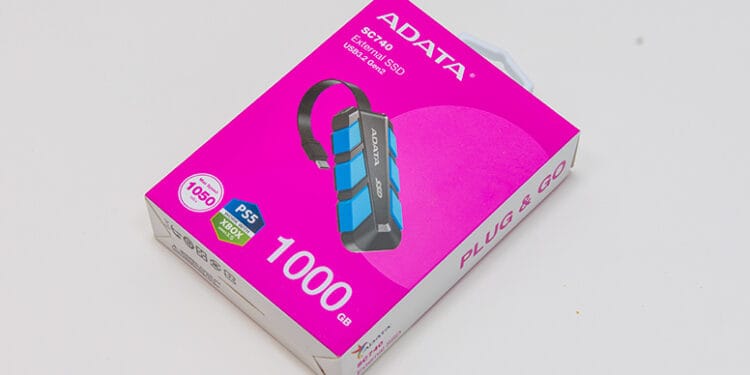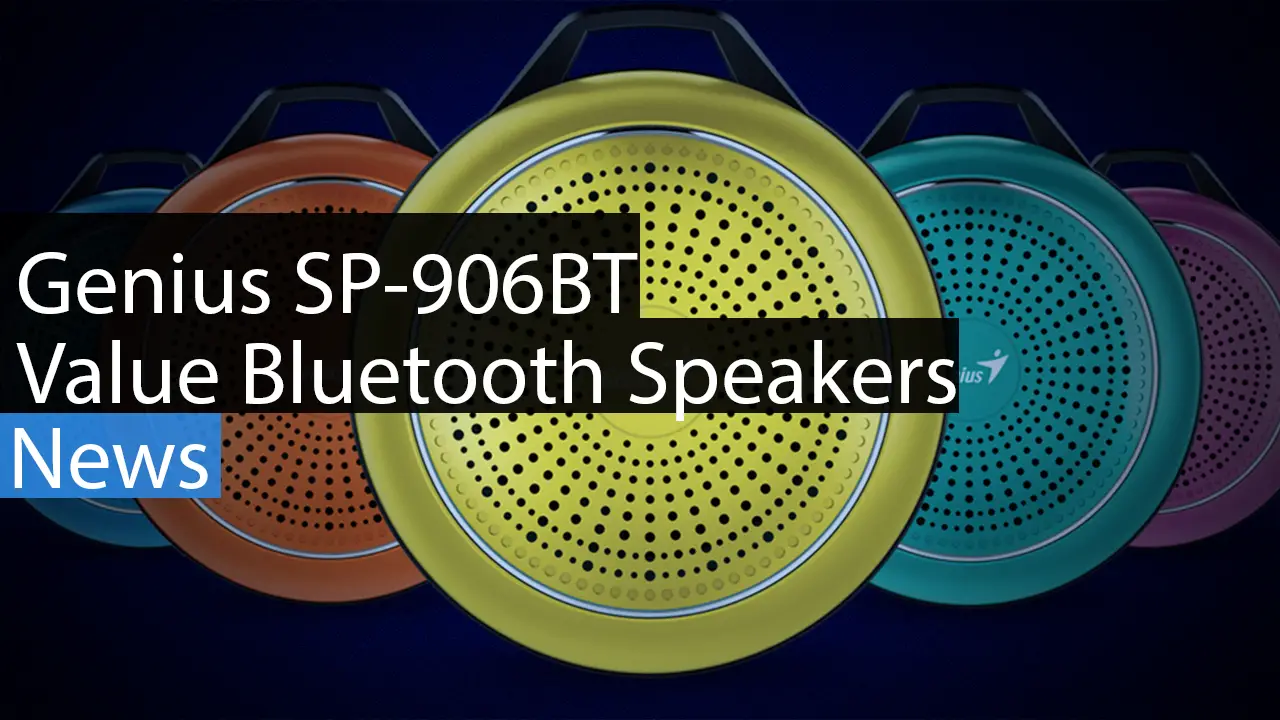
As is our usual M.O. we like to start with the shipping container as the amount of time, effort, and… well… money a manufacture puts into a cardboard box can tell you a lot about their priorities. After all, these shipping containers are going to be discarded by the majority of buyers as soon as they buy them. So if a company cares more about the bottom line than the customer… they will cut corners here as even if one out of a hundred gets damaged in transit that still costs less than what a good shipping design will set them back.
In this regard the AData SC740 shipping container is well above average for a flash drive. Combining copious amounts of external cardboard with a good internal ‘clam shell’ / 2-piece plastic housing is a known good combination. One that is the de-facto standard for companies who actually care about customer satisfaction. With that said the exterior is a little on the… colorful side of the spectrum and while it certainly is inarguably attention some may feel it is edging out of the ‘attention-getting’ zone and into the garish end of the spectrum. We would not go that far, but some professionals may be turned off by this more ‘younger’ approach to color design.
With that said, it does have all the necessary information that a buyer needs to make an informed decision and while “colorful” it is almost impossible to mistakenly purchase the wrong capacity variant… as the capacity text is bigger than the performance it boasts. As such we do like this box, and think that most will too. Put another way, it does give a mostly positive first impression and that is a Good Thing™.

In a similar vein, the list of accessories that accompanies the SC740 1TB is easy to go over as there are almost nothing included. You get a product guide… and that is it. No USB Type-C to Type-A adapter. No free software. Not even a 1/2/3/etc. month ‘free’ subscription to one of the various Adobe cloud plans. To be blunt we have zero issue with this. We rather a company cut corners here in the included ‘goo-gaws’ section than in the warranty. In case of the SC740 is not one, not even three… but a full five years. That is indeed impressive, to say the least.

Moving on. On first perusal of the SC740 a few key components of this design do jump out and are almost seemingly highlighted by the design team. First and foremost this is an unusual-looking flash drive. In some ways, it is very reminiscent of the older ‘thumb drive’ style flash drives… albeit one that has been supersized.

In other ways, it looks like an upgraded M.2 to USB adapter. One that has been given the ‘harsh environment’ treatment. What we mean by this is while the industry trend is to hide the fact that the internals are modified M.2 NVMe SSDs, AData embraces the obvious “M.2” heritage. Embraces it and then takes a page from LaCie by making it blatantly obvious that it can take copious amounts of punishment via the use (and highlighting) of rubber inserts – aka rubber (baby) bumpers.

We think that this unusual duality is a very, very smart move on AData’s behalf. On the one hand people these days are impatient. They want even their portable storage devices to be blazing fast… yet most portable devices fail to live up to their hopes and dreams of instant data transfers. The only noticeable exception to that rule is the adapter niche. Where one takes an internal M.2 NVMe SSD and sticks it in an aftermarket USB adapter chassis that uses a PCIe to USB bridge/host controller to translate from PCIe to USB. That is how you max out the performance of portable external storage. That however is how you also max out your budget as the ‘good’ adapters can easily set you back the cost (or even more) of the SC740 all on its own. Thus with its aggressive styling the SC740 just plain looks fast to the average buyer… and yet its form-factor also looks fast to the typical experienced buyer. Which is a neat trick that few can pull off.
Ironically, people are also very concerned with durability when it comes to their portable storage devices. After all, when you are dropping 75 bucks on a flash drive and that drive is as lightweight (~40grams) as the SC740 is… safety of their data is going to be at the forefront of their minds. This is the duality of the modern buyer and yet the SC740’s design simultaneously puts people’s minds at ease over speed and safety.
With all that said, the SC740 has been built with a lower price point in mind so while it is durable it is not as durable as some. Bluntly stated the SC740 series can, and has the mil-spec certification to back it up, take a beating. What it cannot shrug off is water or dust damage. This is a missed opportunity as it would have literally taken seconds to heat seal both halves of the plastic chassis and added at most a dollar to the build cost by adding in a silicon sleeve for the “integrated” USB Type-C cable. Those two minor tweaks would have made it ‘water proof’ and made it ‘dust proof’.

Thankfully… crazy glue is cheap and a dab of hot glue around the USB cable sticking out the end is not precisely a difficult endeavor. So, if you do want a shock, water, and dust-resistant device the SC740 is easy to mod into a “IP68” drive.

Moving on. With portable devices… portability is kind of key. It’s right there in their niche’s name. In this regards, and much like the missed opportunity with IP certifications, the SC740 does some things extremely well, and some things are a bit unusual. We have already gone over the chassis form-factor and find that they got that right as while it is a bit big, its lightweight nature combined with its “not too big” footprint is fine. The same is only somewhat true of the cable. On the one hand, we like the idea of integrated cables… as they cannot be lost. We also like the fact that this cable is easy to replace (more on that in a moment). We even like the integrated hook and loop to keep said cable tucked away during transportation.

What we do not like is the fact that when ‘secured’ for transport said cable noticeably adds to the foot print and turns a thumb-drive-like device into one that is not exactly comfortable to put in a pocket. AData would have been better served with a ‘wrap’ style design for the cable. One where it is wrapped around the device for transportation and unwrapped when you want to use it. Counteracting that transportation issue is the fact that this cable is ‘integrated’ and thus the weak link in most ‘thumb drives’ is negated. We have lost count of the number of flash drives we have fixed over the years that had perfectly working hardware and it was just a contact pin in the USB header (or solder joint on the header) that failed. So while the SC740’s USB cable’s header is still only rated for USB levels of insertion and removal. It is easy to replace this cable when it fails. Just as all USB cables eventually fail.

With that said, this cable is technically integrated and you do have to be comfortable with shucking the SC740 to replace it. Thankfully that is a very easy endeavor (as they did not heat seal the chassis). Simply take two spudgers (a thin metal and a thicker plastic is best) and run along the seam. It will split open and then using the second you can pry a bit of it open. Rinse and repeat and the two halves will pop apart.

Allowing us to get a good look at the internals. First up. Yes. That is indeed a bog standard USB Type-C cable attached to the PCB. Thus, it is easy to replace a failed one. Just make sure you replace it with a flat “ribbon style” USB Type-C cable as otherwise you will not be able to close both halves of the plastic chassis without first getting out ye olde Dremel tool and turning the square opening into a ‘round’ opening.

Next. Yes. That is indeed a bog standard Victory Giant Tech 60x26mm PCB. That however is not unusual for fabless manufacturers, like AData, in this market niche. Put simply, VGT may not be a ‘giant’ of the industry but they do a lot of the fabrication for a lot of name-brand companies and have done so for many years now.

With that said the internals of this device do not match the specifications. On paper, this is a 10G / USB 3.2 gen 2×1 device listed at ‘up to’ 1050MB/s performance levels. Yet these parts are not mid-tier in the least. They are the same as what you will find inside a ’20G’ / USB 3.2 Gen 2×2 flash drive rated for ~2,000MB/s.

Take for instance the four 256GB Micron 176-Layer NAND ICs. Yes. That NAND is a bit dated but has been used in many PCIe 4.0 1TB M.2 drives. Put bluntly, those four NAND ICs should be able to easily saturate and USB 3x bus… and even USB 4 would have a tough time keeping up. With that said, while it was a nice bonus to see them, it was not particularly unexpected. These days all modern NAND can saturate a USB bus and its more a case of the differences in prices between ‘good enough’ and ‘premium’ being so little that few opt to round this corner on all but teeeeeny tinnnny USB drives.

The same is not true of the controller. Yes, we fully expected to see an ‘all in one’ controller. One that is both a PCIe NVMe storage controller and PCIe to USB bridge controller… as they are cheaper than purchasing two separate ICs. What was not expected was to see a Silicon Motion SM2230 controller. Yes. It is the ‘g’ variant… but this controller is typically used in more expensive models and is serious competition for PHISON and their “all in one” controllers. Bluntly stated this is a USB 3.2 gen 2×2 “20G” controller. Not a hooptie 10Gbps capable controller. Which makes zero sense… as there is no hooptie hardware to be seen here.

At this point in the review process, we paused everything and reached out to AData. We want to make sure that this was not a mistake. That we had not been given a “special” or “reviewers” version. They firmly stated that was not the case and that this was a retail sample. They just do not guarantee anything above 1000/1050MBps performance levels. Meaning that the internals may change at some point in the future… but for the time being one is getting a 20Gbps drive with mil-spec safety specs for the price of a 10Gbps drive.

Needless to say, we quickly reassembled and resumed testing to make sure that there was not some firmware fu… err… firmware funny business going on. One that was artificially limiting performance so that the SC740 did not “rob” sales from AData’s more premium (aka higher priced) models. As you can see from the above screen capture of the drive (in a used stated we might add) the firmware is not limiting anything. Neither is the NAND. Neither is the controller. In other words, one will get well in excess of what is guaranteed with the SC740. Needless to say, when one combines a good (if not perfect) form-factor with excellent (more like insane for its specified class) performance the end results are smile-worthy. So let’s go over them before getting to the (almost forgone) conclusion!










